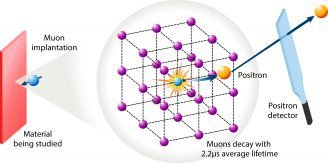Muon Spin Rotation and Relaxation Spectroscopy (µSR)
What is it?
Positive Muon Spin Rotation and Relaxation Spectroscopy is an experimental technique that uses positively charged muons for studying materials. It generally complements scattering techniques, e.g. X-ray or neutron scattering, and may become a valuable alternative for the substances that act as strong incoherent scatterers or neutron absorbers. The technique is often used to study superconductors and magnetic materials, including weak and/or disordered magnets.
What is a muon?
Muons are similar to electrons with the same spin of ½ and either -1 or +1 charge. However they have a much greater mass, being over 200 times heavier than an electron. Thanks to their tunable energy at production they can penetrate deeply into materials compared to electrons, x-rays or gamma rays allowing larger and thicker objects to be studied, even inside pressure cells. They can be selectively implanted at a depth of 1-100 nm below the sample surface, in the so-called Low Energy beams.
The + 1 muon is called a positive muon, or antimuon, and µSR experiments are performed with these. Muons have a mean lifetime of 2.2 microseconds (longer than many other unstable particles) and undergo weak decay. A positive muon (µ+) decays to a positron (e+) and two neutrinos, according to:

The bar over the symbols indicates an antiparticle. The two neutrinos from the decay are not detected in the experiment.
Muons are produced by naturally occurring cosmic rays or particle accelerators. Muon experiments need high fluxes of muons, meaning that only particle accelerators will do. Facilities at PSI (Switzerland) and ISIS (UK) are capable of running µSR experiments.
What happens in the technique?
Positive muons stop in the substance placed in the muon beam. In general, after a quick deceleration, the muons localize in interstitial positions and decay. The positrons released from these decays are detected and are able to provide information on the spin polarisation of the muon (see picture below). The muon spin precesses, like a spinning top, around the local magnetic field and this rotation is mirrored in the positron distribution. The technique is very sensitive and it can detect weak magnetic moments that are hard to probe with other methods.

Sometimes, the positive muons pick up an electron from within the substance. This creates a muonium atom which behaves like a light unstable version of hydrogen, enabling the technique to be used to model the behaviour of hydrogen atoms within materials too.
Acknowledgements: Roberto de Renzi, UNIPR and Thomas Holm Rod, ESS
Reference and more info: STFC Muon Flyer